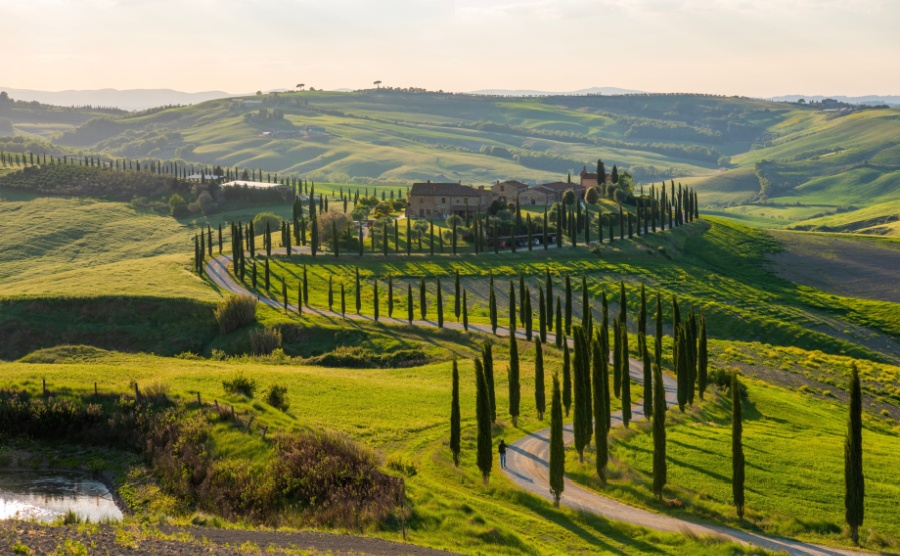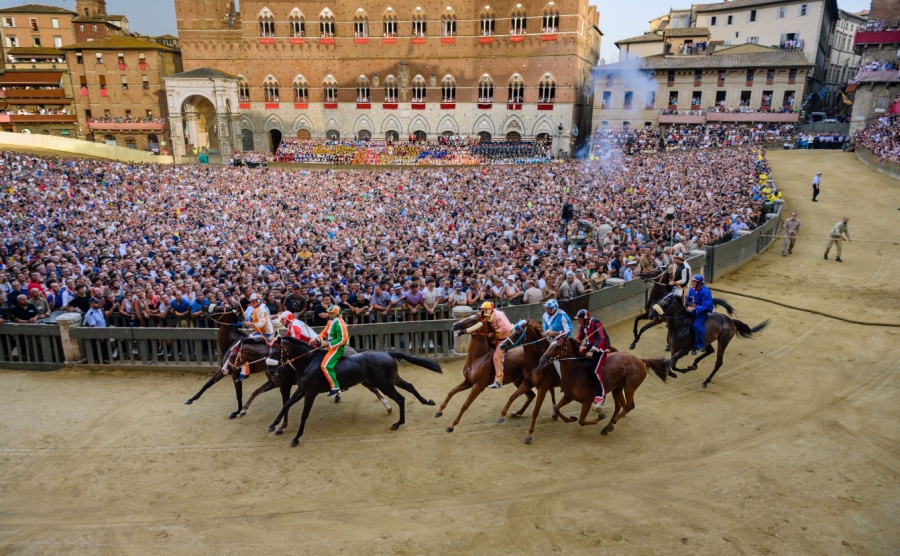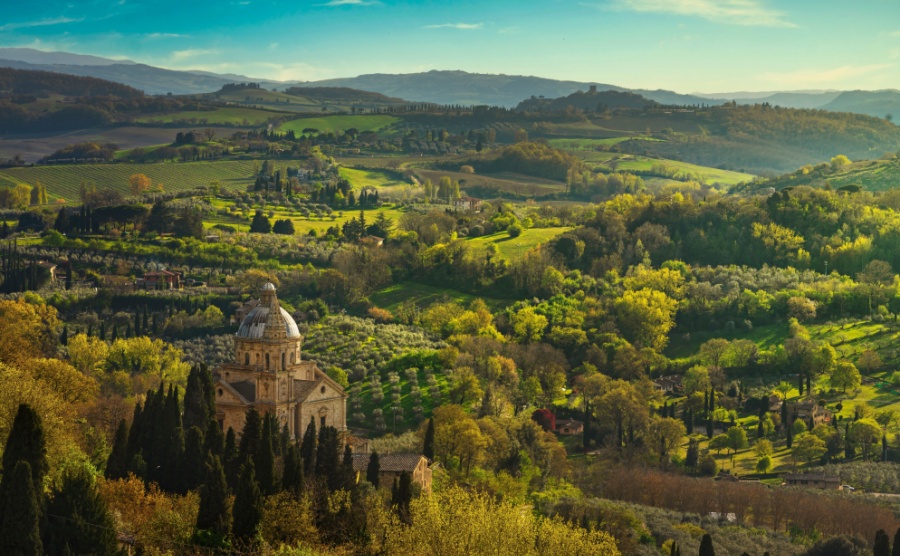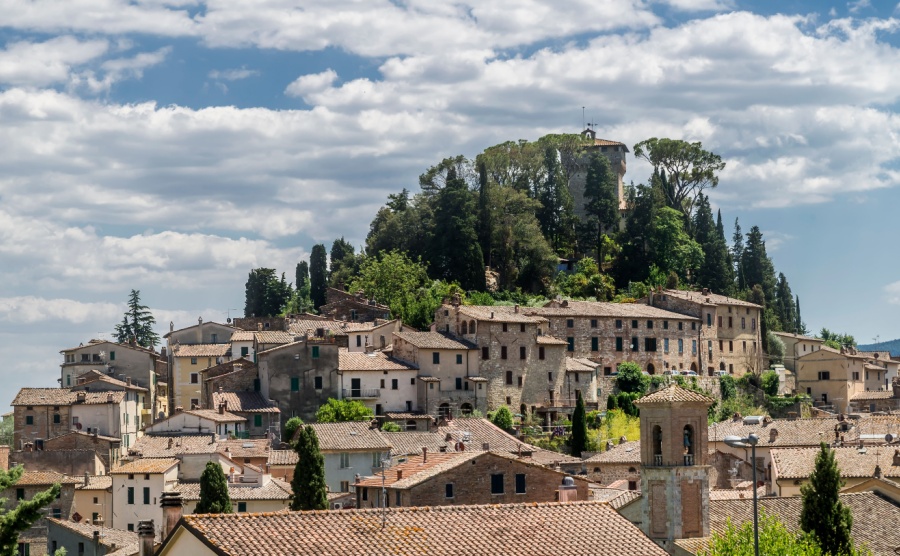The province of Siena is the quintessential Tuscan landscape of country lanes lined with cypress trees, leading to castles, farmhouses and medieval villages. The views go on for miles, across rolling hills, vineyards and olive groves.
Siena is the second largest province in Tuscany, covering an area of just under 4,000 square kilometres – similar to an English county such as Kent or Wiltshire. However, the population of the province is barely 265,000, less than half of either of those counties. So Siena is exceptionally rural, with most residents living in farmhouses, villages and towns, including Siena itself. Typical Tuscan stone and terracotta coloured houses blend harmoniously with the surrounding landscape.

Your new home in Siena?
As Siena is such an attractive and popular province, the cost of living there is relatively high. However, local healthcare is considered above average and the quality of life is very good. At the heart of Tuscany, owning a property here provides a good base from which to explore vineyards, rolling hills, and beautiful historic towns.
Find homes in Tuscany via our property portal.
The city of Siena
The city of Siena is one of Tuscany’s “Cities of Art” and is listed by UNESCO. It’s only a medium-sized town of 50,000, but has produced some of the greatest Italian painters of the 13th and 14th centuries. You will find masterpieces displayed in palazzo, galleries and museums across the city.
Siena is also famous for it’s Palio horse race, which speeds around Piazza del Campo twice a year. This amazing spectacle, full of drama and excitement, draws in crowds of people.
Siena’s historic centre
The historic centre of this wonderful medieval city is enclosed within a seven-kilometre wall and has remained largely unchanged over the centuries. Between the 12th and 15th centuries Siena preserved its Gothic appearance and has become a much-appreciated architectural work of art.

The famous palio horse race
Its red brick walls, Sienese arches and terracotta tiled roofs blend beautifully with the landscape. Due to a large pedestrianised area, Siena is a very pleasant place to take a stroll and enjoy the treasures of Romanesque and Renaissance Italy.
The newer parts can get busy with cars, but there are many cycle lanes to help relieve vehicle traffic. There are several restaurants, wine bars, clubs and live music venues. During special events and festivals, the nightlife flows through the streets. There is a great community atmosphere, and everyone can feel safe walking around the town.
Getting to Siena
The nearest airport to Siena is Florence (Aeroporto di Firenze Amerigo Vespucci), which is about 75-minutes’ drive. Perugia airport, in Umbria, takes slightly longer. You can also fly into Fiumicino Airport near Rome and get a flixbus to Siena, which takes around three hours. Alternatively, you can travel by trains from Pisa airport, which takes just over two hours.
UNESCO sites in Siena Province
The historic towns and stunning landscape of Siena province are so highly regarded that three historic centres and the landscape itself have been recognised by UNESCO. These are the historic centres of Siena, San Gimignano and Pienza and the Val d’Orcia.
The Val d’Orcia is a large country area to the north and east of Mount Amiata, close to the border with Umbria. It is listed by UNESCO because its rural landscape has barely changed since the Renaissance, made up of rolling hills, vineyards, rows of cypress trees and isolated farmhouses. It is this stunning countryside and hills that are the big attraction in the Val d’Orcia.
You will also hear part of Siena province referred to as Crete Senesi. This is the area south-east of the city of Siena. Its greyish hilly expanses of clay soil give the area its name – which may not sound especially attractive, but does provide fertile ground for white truffles!
There are many lovely towns and villages in Siena province. Here are five:
Asciano
Asciano is an ancient village south-east of Siena within Crete Senesi. Proof of its habitation since ancient times are two important Etruscan necropolises.
The village has a medieval layout, with piazzas and historic buildings. Piazza del Grano is at the heart of the village and boasts a lovely 15th century fountain. Here is where the population of around 7,000 people gather for events. The nearby hills have also created a natural amphitheatre, where they hold the Asciano Sound Festival.
Agriculture and tourism play an important part in the economic life of the town, with quarries in the area producing marble and terracotta.
The nearest airports to Asciano are Florence, drive time 90 minutes, and Perugia 65 minutes.
Montepulciano
Montepulciano is a typical Tuscan hilltop town with a population over 14,000. The town has extremely attractive art and architecture as well as spectacular views across the Val d’Orcia and Val di Chiana.

The countryside of Siena province, near Montepulciano
Piazza Grande is at the highest point of Montepulciano and is home to the 14th-century Palazzo Comunale, with a tower offering views of the surrounding countryside. The Torre di Pulcinella is a clock tower topped by Pulcinella, one of the characters from the commedia dell’arte.
Famous for its wines, Brunello di Montepulciano and Vino Nobile di Montepulciano, the town holds several wine festivals and open cellars. Other events in the area include, tasting chocolate, a saracen joust, barrel racing, cart racing and street food.
The nearest airports to Montepulciano are Perugia airport, at one hour’s drive, and Florence in 90 minutes.
Pienza
Located in the Val d’Orcia, Pienza is a smaller village of just 2,000. On a summer’s evening you will see people tending their plants or sitting on chairs by their front door. A friendly smile and greeting of “Buonasera” is all part of the charm.
The pretty stone houses of Pienza are nestled together, surrounded by green countryside. Known as the “ideal” city of the Renaissance, the historic centre was declared a World Heritage Site by UNESCO in 1996. It is thanks to Enea Silvio Piccolomini, who later became Pope Pius II, who wanted to transform the pre-existing medieval village of Corsignano into his “ideal city”.
Today, Pienza attracts many visitors, who come not only to admire the village and scenery, but also to taste some of the local delicacies. Such as, the famous Pienza pecorino cheese, wine and the extra virgin olive oil. Even though Pienza has so few residents, there are still shops, bars and restaurants.
Pienza countryside
For the best countryside views, you should take a walk along Via dei Casello. Known as the “panoramic walk”, this pedestrianised street near the cathedral has lovely viewpoints. The countryside is so beautiful that the Terrapille farm road, south of Pienza, was chosen for the final scene in the film Gladiator, where you see Maximus walking through a field, with a track in front of him with cypress trees, leading to a farmhouse.
A prominent music executive from New York, called John Voigtmann, was so taken by the area, that he made a life-changing decision to move to Pienza, with his wife. At first, the couple renovated a farmhouse, then they created a boutique hotel with restaurant in the village, called La Bandita Townhouse.
Nearest airports to Pienza are Florence 1 hour 37 minutes, and Perugia 1 hour 18 minutes.
Sarteano
Between the Valdichiana and the Val d’Orcia, lies Sarteano, with a population under 5,000. As you approach the village, you will notice a castle with a thousand-year-old square keep, standing out against the backdrop of Mount Cetona. Sarteano castle towers above the village and even the centuries-old holm oaks.
Here you can enjoy breathtaking views, and pleasant walks. As well as walks around the village and trails on the outskirts, there is also an ancient Etruscan road to discover, heading in the direction of Boccalaciana and Peschiera.
Finds from Etruscan necropolises of between the 9th and 1st centuries BC, can today be seen in the collection of the Museo Civico Archeologico di Sarteano, housed in the 16th-century Palazzo Gabrielli. As you stroll around the streets you will see other fine palazzo and churches.
Nearest airports to Sarteano are Florence 1 hour 27min, Perugia 1 hour 11 minutes.
Cetona
Cetona, is a picturesque village of stone, brick and pastel-coloured houses that spiral around a green hill. At the very top of the hill, a castle tower peeks out from the trees, with an unusual roof and viewing terrace design at the top. In fact, the castle has been renovated to provide seven-bedroom luxury holiday rental accommodation with pool.
The cluster of medieval houses, newer properties at the bottom of the hill, and local farms are home to around 2,500 people. The Cetona municipality includes a mountainous area, hills, valleys, vineyards and olive groves dotted with cypresses and pines.

Cetona
Cetona has been awarded the Orange Flag by The Italian Touring Club. The renowned tourist-environmental quality mark is given to places that not only enjoy a valuable historical, cultural and landscape heritage, but also offer tourists a high level of hospitality.
Nearest airports to Cetona are Florence 90 minutes drive, and Perugia at 70 minutes.
Property for sale in Siena Province
in 2024, there are still a few houses available that are in need of renovation. Prices start at around €60,000. But if you are looking for some land with a large property to renovate, you will need to spend over €270,000.
However, small Farm houses that are liveable start at €170,000 and you can get some really nice villas and farmhouses for between three and four hundred thousand euros.
For a 350m2 farmhouse surrounded by gorgeous scenery you might pay a little over €700,000. An apartment in a historic village centres costs from €60,000.
Properties for sale in the Province of Siena can be found on Your Overseas Home.











